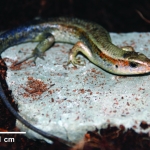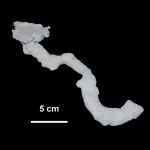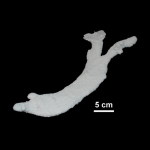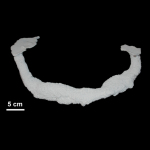Gold Skink(Mabuya multifaciata)
For full details see Catena and Hembree (2014) in Experimental Approaches to Understanding Fossil Behavior (Topics in Geobiology, Springer)
Description of Organism
- Medium-sized skink with well-developed limbs, olive-grey coloration with yellow throat, two dark brown dorsolateral lines and numerous green to brown dorsolateral ocelli
- Adults reach a snout-to-vent (SVL) length of up to 12 cm
- Range extends through China, India, Malaysia, the Philippines, and New Guinea
- Inhabits soils near forest edges and floodplains
- Feeds on small insects
Burrowing Technique
Mabuya multifasciata burrows using an intrusion and compaction technique regardless of sediment composition. The skinks preferentially begin their burrows in preexisting cracks on the sediment surface. The front legs are used to expand the opening in the sediment surface, making it wide enough to force its head into. The hind legs are used to compact and stabilize the sediment around the burrow entrance. As the skink forces its body into the sediment, it uses lateral undulations of the head and body to compress the surrounding sediment and widen the burrow. The burrowing technique results in a burrow with dimensions similar to those of the trace maker.
Burrowing Technique Video
Burrowing Behavior
Mabuya multifasciata utilizes its burrows for temporary shelters to permanent dwellings. During periods of stress or disruption, the skink will rapidly burrow, forming ramps as a means of escaping the surface disturbance. The surface openings of permanent dwellings are used as ambush sites for catching prey. Open burrows are produced in all types of sediment, except those with low moisture content (<20%).
[nggallery id=43 template=caption]
Trace Morphology
Mabuya multifasciata produces three distinct burrow arhitectures: subvertical ramps, branching burrows, and U-shaped burrows; examples of each are shown below. Each photo is linked to an information page about the specific burrow architecture shown.



